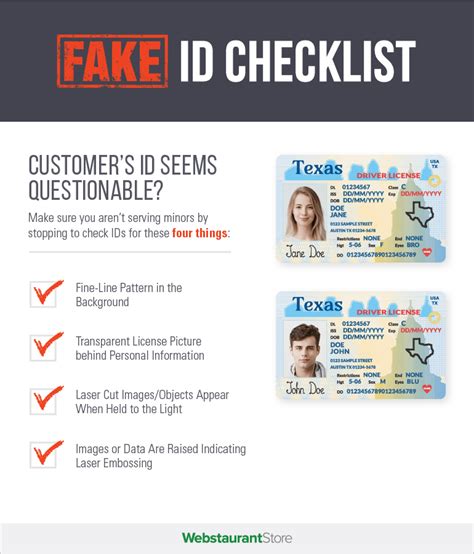In today’s digital age, it’s more important than ever to be able to spot a fake ID. With the rise of online identity theft and fraud, businesses and individuals need to be aware of the telltale signs of a forged or altered identification card.

The Importance of Spotting Fake IDs
According to the United States Department of Justice, over 1.4 million cases of identity theft were reported in 2020. Of those cases, over 40% involved the use of fake IDs. This alarming statistic highlights the need for businesses and individuals to be vigilant in their efforts to detect and prevent identity fraud.
Consequences of Accepting Fake IDs
Accepting a fake ID can have severe consequences for businesses and individuals alike. For businesses, it can lead to:
- Legal liability for identity fraud
- Financial losses due to fraudulent transactions
- Damage to reputation
For individuals, accepting a fake ID can lead to:
- Identity theft
- Fraudulent financial activities in their name
- Criminal charges
How to Spot a Fake ID
Spotting a fake ID requires a keen eye and attention to detail. Here are some key indicators to look for:
1. Physical Characteristics
- Material: Real IDs are typically made of a durable, high-quality plastic. Fake IDs may use cheaper or thinner materials that feel flimsy or flexible.
- Holograms and security features: Real IDs often incorporate holograms, watermarks, and other security features that are difficult to counterfeit. Check for the presence of these features on the ID you’re inspecting.
- Printing: The printing on real IDs is typically crisp and clear. Fake IDs may have blurry or pixelated printing.
2. Personal Information
- Name: Check that the name on the ID matches the person presenting it. Look for misspellings or inconsistencies.
- Date of birth: Ensure that the date of birth matches the person’s appearance. Be wary of discrepancies between the age on the ID and the person’s physical appearance.
- Address: Verify that the address on the ID matches the person’s current address. Check for inconsistencies or potential red flags, such as a PO box or a known address for fraudulent activities.
3. Photo
- Quality: The photo on a real ID is typically high-quality and shows the person’s face clearly. Fake IDs may have a low-quality photo or a photo that doesn’t match the person presenting it.
- Alignment: The photo on a real ID is typically centered and aligned correctly with the other features on the card. Fake IDs may have a photo that is off-center or misaligned.
4. Signature
- Authenticity: The signature on a real ID is typically original and matches the signature on file with the issuing authority. Fake IDs may have a forged or reproduced signature.
- Comparison: Compare the signature on the ID to a known signature for verification. Look for differences in style, pressure, and flow.
5. Issuing Authority
- Validity: Check that the ID was issued by a legitimate issuing authority. Be wary of IDs that are issued from unknown or questionable sources.
- Expiration date: Ensure that the ID has a valid expiration date. Real IDs typically have a set expiration date, while fake IDs may have an extended or altered expiration date.
Table 1: Physical Characteristics of Fake IDs
| Characteristic | Real IDs | Fake IDs |
|---|---|---|
| Material | Durable, high-quality plastic | Cheap, thin, flimsy materials |
| Holograms and security features | Present, difficult to counterfeit | Absent or poorly imitated |
| Printing | Crisp, clear | Blurry, pixelated |
Table 2: Personal Information Discrepancies
| Information | Real IDs | Fake IDs |
|---|---|---|
| Name | Matches the person presenting | Misspellings, inconsistencies |
| Date of birth | Matches the person’s appearance | Age discrepancies, obvious alterations |
| Address | Matches the person’s current address | PO boxes, known addresses for fraud |
Table 3: Photo Discrepancies
| Feature | Real IDs | Fake IDs |
|---|---|---|
| Quality | High-quality, clear | Low-quality, blurry |
| Alignment | Centered, aligned | Off-center, misaligned |
Table 4: Signature Discrepancies
| Feature | Real IDs | Fake IDs |
|---|---|---|
| Authenticity | Original, matches on file | Forged, reproduced |
| Comparison | Matches known signature | Differences in style, pressure, flow |
Additional Tips
- Use a UV light: Some fake IDs have UV markings that are not visible to the naked eye. Shine a UV light on the ID to check for these markings.
- Check for raised lettering: Real IDs often have raised lettering on the front and back. Fake IDs may have flat or uneven lettering.
- Use an ID scanner: If you have access to an ID scanner, it can help you quickly verify the authenticity of an ID.
- Trust your instincts: If something about the ID seems suspicious, it’s best to err on the side of caution and reject it.
Conclusion
Spotting a fake ID requires diligence and attention to detail. By following the tips and guidelines outlined in this article, businesses and individuals can protect themselves from the risks associated with accepting fraudulent identification. Remember, it’s always better to be safe than sorry when it comes to preventing identity theft and fraud.
